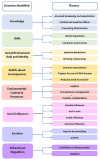Factors influencing health professionals' use of high-flow nasal cannula therapy for infants with bronchiolitis - A qualitative study
- PMID: 37009298
- PMCID: PMC10060553
- DOI: 10.3389/fped.2023.1098577
Factors influencing health professionals' use of high-flow nasal cannula therapy for infants with bronchiolitis - A qualitative study
Abstract
Aim: To explore the factors influencing the use of high-flow nasal cannula (HFNC) therapy for infants with bronchiolitis.
Design: Qualitative approach using semi-structured interviews.
Methods: The semi-structured interviews (face-to-face or virtual) were conducted between September 2020 and February 2021. Deductive content analysis was used to map key influencing factors for use of HFNC therapy to the Theoretical Domains Framework (TDF).
Results: Nineteen interviews were undertaken before reaching thematic saturation (7 nurses, 12 doctors) in emergency departments and paediatric wards from four purposively selected hospitals in Australia and New Zealand. Influencing factors were mapped to eight domains in the TDF with 21 themes identified. Main findings included: (1) Health professionals' expectations of HFNC therapy on patient deterioration, work of breathing and oxygenation; (2) Staff emotions relating to concern and anxiety about deterioration and "need to do something"; (3) Social influences from other health professionals and parents and (4) Environmental factors relating to logistics of care and patient transfer considerations. These factors, combined with the ready availability of HFNC equipment and health professionals having the required skills to administer the therapy, contributed to its initiation.
Conclusion: Individual/personal and contextual/environmental factors contribute to the use of HFNC therapy for infants with bronchiolitis. It is evident these influences contribute substantially to increased use, despite evidence-based guidelines recommending a more nuanced approach to this therapy. These findings will inform a targeted implementation intervention to promote evidence-based use of HFNC therapy in infants with bronchiolitis.
Keywords: bronchiolitis; doctors; evidence-based care; high-flow nasal cannula therapy; implementation intervention; nurses; paediatric; theoretical domains framework.
© 2023 O'Brien, Haskell, Tavender, Wilson, Borland, Oakley, Dalziel and Gill.
Conflict of interest statement
The authors declare that the research was conducted in the absence of any commercial or financial relationships that could be construed as a potential conflict of interest. The reviewer [PP] declared a shared affiliation with the authors [SO, SW, FG] to the handling editor at the time of review.
Figures
References
LinkOut - more resources
Full Text Sources


